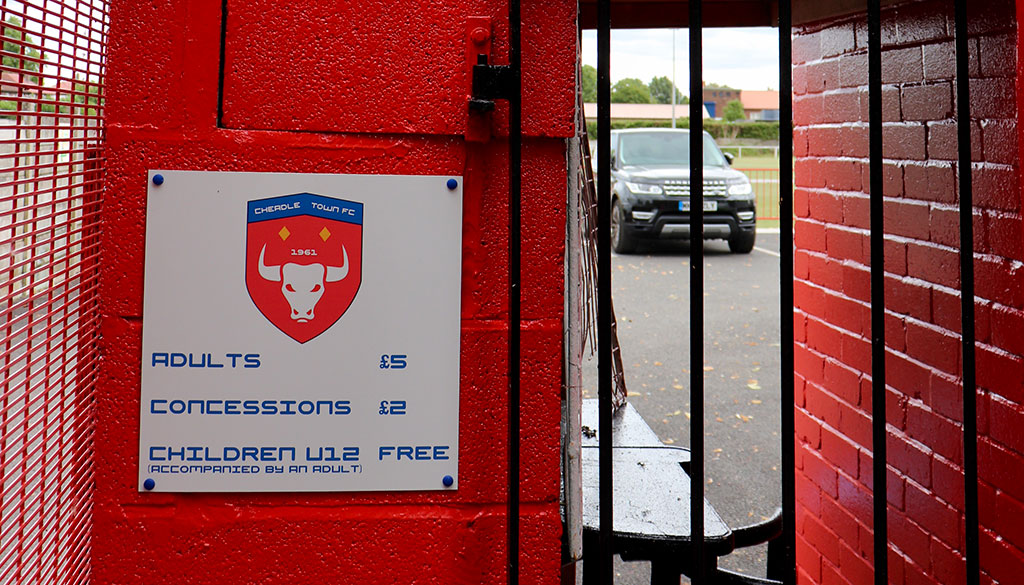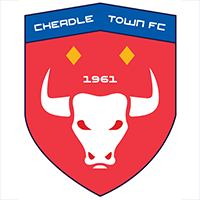
Emblematically Speaking - Cheadle Town
Tue 31st October 2017 | Cheadle Town | By Stewart Taylor
This week we look at another club emblem which reflects the coat of arms of the town that the club represents - though many refer to Cheadle as a village or is that just a small part of what is called a town?
It can get very confusing and let’s just add to the potential confusion by saying that the coat of arms seen here is based on the coat of arms granted to Cheadle and Gatley Urban District Council in December 1955.
We have spoken before in this series about local government re-organisations so we don’t need to go there again except to say that Cheadle is now part of Stockport Metropolitan Borough, an entity which, not surprisingly, has a coat of arms but they bear little resemblance to one referred to in this article.
As with many coats of arms this one gives us a wealth of information and an in depth study of the history of the families referred to later gives a very comprehensive review of how we got from a “wasteland” back in the immediate post Domesday book period to what we see today.
If we start, as has become the norm in this series, with the shield, we can identify five different devices and that’s before we consider the significance of the colourways.
The most familiar to regular readers of these articles is the wheatsheaf representing Cheshire and, specifically, the Earls of Chester.
The two golden lozenges to either side of the wheatsheaf are taken from the coat of arms of the Stopford family.
The name of Stopford goes back to Norman times and, as with many family names, there have been various spelling variations down the years, one of which is Stokeport. This gives us the clue that the family lived in the Stockport area.
Another reference lies in the use of the blue colour for the upper part of the shield (the chief) which refers to Lord Etchells who was a tenant of the Baron of Dunham Massey and father of Sir Robert Stopford a Norman nobleman.
The red (gules) central W is from the arms of the de Chedle family. This family, previously known as the de Dutton family, acquired the land of which Cheadle is now a part in the 13th century. This acquisition heralded the start of the development of the town of Cheadle.
The two bulls’ heads and the eagle continue the theme of recognising local families.
The bulls’ heads represent the Bulkeley family who owned tracts of land in the area.
For a number of years back in the 14th and 15th centuries, what we now know as Cheadle was called Chedle Bulkeley.
The eagle comes from the Moseley family of Manchester and the area became know as Cheadle Moseley when the estate was acquired by the family after the English Civil War (1642 – 1651).
If we move to the crest we see an oak tree – a regular feature of the local landscape – with five acorns. These acorns represent the five areas of the Cheadle and Gatley Urban District Council - Cheadle, Cheadle Hulme, Gatley, Heald Green and Adswood.
The final motif is our old friend the fleur-de-lis and, as before, it represents St Mary. St Mary’s Church (mid 16th century and built in the Perpendicular style) is on the High Street in Cheadle and well worth a visit – Grade I listed.
Where there might have been a motto underneath the arms we now see a simple designation of Cheadle Town FC in Green on a White background representing the playing colours of the club.
There is not enough space in an article of this nature to explore in great detail the wealth of information available to describe the development of Cheadle, but it is a fascinating story and well worth further study for those with an interest in this part of Cheshire.
But just a note on this, the spellings of family names vary down the centuries as many old written records were taken from word-of-mouth sources.
We were also in the age of male primogeniture where sons took precedence over daughters in terms of inheritance. It is instructive to note that Royal Houses in this country tended to come to an end after we had a queen as monarch.
As an example, the last of the Tudors was Elizabeth I and then we had the Stuarts. This was followed by other examples meaning that the “family name” is lost. Given this, some the links in the family chains can be a little bit difficult to follow.
With thanks to Karl Florczak of Cheadle Town FC for his help in compiling this article.
 Emblematically Speaking - Cheadle Town
Emblematically Speaking - Cheadle Town
Tue 31st October 2017 | Cheadle Town
By Stewart Taylor

This week we look at another club emblem which reflects the coat of arms of the town that the club represents - though many refer to Cheadle as a village or is that just a small part of what is called a town?
It can get very confusing and let’s just add to the potential confusion by saying that the coat of arms seen here is based on the coat of arms granted to Cheadle and Gatley Urban District Council in December 1955.
We have spoken before in this series about local government re-organisations so we don’t need to go there again except to say that Cheadle is now part of Stockport Metropolitan Borough, an entity which, not surprisingly, has a coat of arms but they bear little resemblance to one referred to in this article.
As with many coats of arms this one gives us a wealth of information and an in depth study of the history of the families referred to later gives a very comprehensive review of how we got from a “wasteland” back in the immediate post Domesday book period to what we see today.
If we start, as has become the norm in this series, with the shield, we can identify five different devices and that’s before we consider the significance of the colourways.
The most familiar to regular readers of these articles is the wheatsheaf representing Cheshire and, specifically, the Earls of Chester.
The two golden lozenges to either side of the wheatsheaf are taken from the coat of arms of the Stopford family.
The name of Stopford goes back to Norman times and, as with many family names, there have been various spelling variations down the years, one of which is Stokeport. This gives us the clue that the family lived in the Stockport area.
Another reference lies in the use of the blue colour for the upper part of the shield (the chief) which refers to Lord Etchells who was a tenant of the Baron of Dunham Massey and father of Sir Robert Stopford a Norman nobleman.
The red (gules) central W is from the arms of the de Chedle family. This family, previously known as the de Dutton family, acquired the land of which Cheadle is now a part in the 13th century. This acquisition heralded the start of the development of the town of Cheadle.
The two bulls’ heads and the eagle continue the theme of recognising local families.
The bulls’ heads represent the Bulkeley family who owned tracts of land in the area.
For a number of years back in the 14th and 15th centuries, what we now know as Cheadle was called Chedle Bulkeley.
The eagle comes from the Moseley family of Manchester and the area became know as Cheadle Moseley when the estate was acquired by the family after the English Civil War (1642 – 1651).
If we move to the crest we see an oak tree – a regular feature of the local landscape – with five acorns. These acorns represent the five areas of the Cheadle and Gatley Urban District Council - Cheadle, Cheadle Hulme, Gatley, Heald Green and Adswood.
The final motif is our old friend the fleur-de-lis and, as before, it represents St Mary. St Mary’s Church (mid 16th century and built in the Perpendicular style) is on the High Street in Cheadle and well worth a visit – Grade I listed.
Where there might have been a motto underneath the arms we now see a simple designation of Cheadle Town FC in Green on a White background representing the playing colours of the club.
There is not enough space in an article of this nature to explore in great detail the wealth of information available to describe the development of Cheadle, but it is a fascinating story and well worth further study for those with an interest in this part of Cheshire.
But just a note on this, the spellings of family names vary down the centuries as many old written records were taken from word-of-mouth sources.
We were also in the age of male primogeniture where sons took precedence over daughters in terms of inheritance. It is instructive to note that Royal Houses in this country tended to come to an end after we had a queen as monarch.
As an example, the last of the Tudors was Elizabeth I and then we had the Stuarts. This was followed by other examples meaning that the “family name” is lost. Given this, some the links in the family chains can be a little bit difficult to follow.
With thanks to Karl Florczak of Cheadle Town FC for his help in compiling this article.


